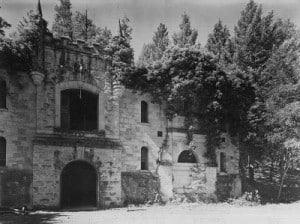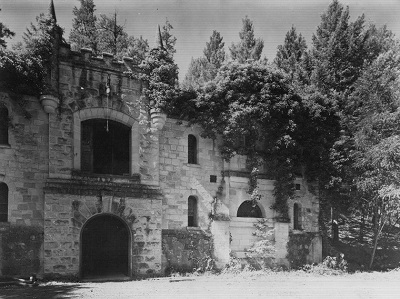Calistoga, Wine and Viticulture
Winemaking in Calistoga, pt. 2
The origins of Prohibition in the United States run as far back as the 17th century when there were strong religious objections throughout New England. The Puritans did not ban drinking alcohol itself, but did outlaw drunkenness. “This lasting connection between politics and liquor, predating the Prohibition era by 150 years, was what made American drinking habits unique. America was an overwhelmingly rural, vastly underpopulated country…The social and political life of small communities, scattered over a vast expanse of land, centered…around those twin meeting places, the church and the tavern, and it was no coincidence in an age devoid of radio, television, mass advertising, and mass-circulation newspapers that tavern keeper and preacher were key community opinion makers – influential figures whose views were taken seriously and discussed interminably.”[1]
The 19th century saw a dramatic uptick in the temperance movement, people devoted to eradicating the consumption of alcoholic beverages. Simultaneously, saloons were rapidly proliferating, becoming as common as coffee shops are today. The Massachusetts Society for the Suppression of Intemperance estimated that in 1814, their residents consumed 4.7 gallons of distilled spirits at home, or nearly 33.5 million gallons total.[2] Once women’s organizations and the women’s suffrage movement threw in their support, the push for national temperance gained traction. The National Prohibition Act, also known as the Volstead Act, became law in the fall of 1919. By January 1920 the 18th Amendment took full effect, banning the production, transport, and sale of alcoholic products. The wine industry dried up almost overnight.
Some vintners were able to convert production to sacramental or kosher wine, while others began producing dried fruit. The Montelena Orchard Company, which had taken over the Tubbs land, made grape syrup and concentrate. The syrup was non-alcoholic, but an entrepreneurial individual could add a few key ingredients and let it ferment into their own homemade wine. In Chicago, more than 15,000 doctors and 57,000 druggists applied for medicinal liquor licenses almost immediately after the Volstead Act became law so they could dispense “medical” liquor.[3] Once the Act was altered in 1921 to allow doctors to prescribe wine in any quantity they deemed fit, even more people who had previously been the picture of health suddenly found themselves in need of “medication.”
Other Napa Valley wineries manufactured grape and raisin cakes. Grape growers could manufacture the cakes under a provision in the Prohibition Act that was intended to keep farmers from being driven to bankruptcy by the new law. Homeowners were supposed to use the cakes to make up to 200 gallons annually of non-alcoholic fruit juice. “Wholesalers used demonstrators (often attractive, well-spoken young women) in large stores to draw attention to the wine-making possibilities of their cakes (or ‘bricks’) while ostensibly warning against fermentation – their straight-faced cautionary patter urging buyers ‘not to place the liquid in a jug and put it aside for twenty-one days because it would turn into wine…and not to stop the bottle with a cork because this is necessary only if fermentation occurs.’ The bricks were sold with a label that read ‘Caution: will ferment and turn into wine’.”[4]
In 1919 there were more than a dozen small wineries in the Calistoga region, and while many closed in 1920, some opened their doors for the first time. The Ghisolfos sold much of their wine just before Prohibition took effect, with bottles going for as little as $1.00 each – about $13 today (Napa Valley Wine Library Association, 1974). The US Marshals Service accused the Ghisolfos of bootlegging and threatened to destroy their inventory. Restaurants were raided regularly, including the Railroad Hotel, Fior D’Italia Café, the Swiss Chalet, and the Monte Carlo Resort (the latter of which was really a speakeasy with a fancy name). The 1924 raid on the Calistoga Hotel was the second largest seizure ever in Napa County during Prohibition. 800 bottles of Chianti and champagne and 700 barrels of red and white table wine were dumped on the ground behind the hotel.[5]
As anti-Prohibition sentiment increased in the late 1920s, Nate Ghisolfo’s case took on greater import. He claimed the impoundment of his wine was done illegally because the Marshals had no warrant. The Ghisolfos were eventually cleared and their wine returned. This marked the first real local success in fighting Prohibition. Ultimately, however, it had little impact. What was left of Napa’s wine industry collapsed almost entirely in 1928. People were switching from wine to hard liquor and moonshine, which were easier, faster, and cheaper to produce. The stock market crashed on October 29, 1929, and shortly thereafter over 85% of the vineyards in California were mortgaged at their sale value or less.[6]
Agricultural crop reports reveal that 1932 was the lowest production value in the county’s recorded history, with grapes valued at $136,500 (nearly $2.3 million today). Franklin Delano Roosevelt became president in 1933, and one of the first moves he made was to call on Congress to repeal the by then largely unpopular 18th Amendment. Less than three weeks after his inaguration, he signed into law the Cullen-Harrison Act legalizing the sale of beer with an alcoholic content of 3.2 percent or less, saying “I think this would be a good time for a beer.” By the end of the year, the 21st Amendment was ratified, bringing about the end of Prohibition.
Many locals believed the wine industry had finally turned the corner to better times. Those who still had money to spend began buying up abandoned and foreclosed vineyards and wineries. They hoped to get in on the ground floor of a new era of viticulture dominance, but it was not to be. There were nearly 700 wineries operating in California in 1920; by the 1930s only 160 were left.[7] Though the Great Depression did not strike Napa County as hard as the rest of the country, people still suffered. Throughout the region, “ghost wineries” haunted the landscape, crumbling remnants of more fruitful times.
Beginning in the late 1930s, some vineyard owners began replacing their vines with walnut and prune orchards, which soon became staple crops in the county. Many vineyards were also converted to grazing land for livestock. Crop reports show a slight increase in the value of the grape crop after the 21st Amendment was passed, but it was not until 1940 that the values began to slowly but steadily rise. Production fell again at the start of World War II.
 In Calistoga, wine remained virtually a thing of the past until 1972 when Jim Barrett purchased Chateau Montelena and hired Mike Grgich as winemaker. Four years later their chardonnay placed first in the Judgment of Paris wine competition. This success proved once again that Napa County could hold its own against France as a premiere wine-growing region. At the dawn of the 20th century there were nearly 140 wineries in operation in Napa County. Prohibition and the Great Depression nearly killed the industry, but today there are more than 500 wineries in operation in the county and about 60 in Calistoga alone.
In Calistoga, wine remained virtually a thing of the past until 1972 when Jim Barrett purchased Chateau Montelena and hired Mike Grgich as winemaker. Four years later their chardonnay placed first in the Judgment of Paris wine competition. This success proved once again that Napa County could hold its own against France as a premiere wine-growing region. At the dawn of the 20th century there were nearly 140 wineries in operation in Napa County. Prohibition and the Great Depression nearly killed the industry, but today there are more than 500 wineries in operation in the county and about 60 in Calistoga alone.
[1] Behr, E. (1996). Prohibition: Thirteen Years that Changed America. New York: Arcade Publishing.
[2] Ibid.
[3] Ibid.
[4] Ibid.
[5] Weber, L. (2001). Roots of the Present: Napa Valley 1900-1950. St. Helena, Calif.: Wine Ventures Publishing.
[6] Ibid.
[7] Sosnowski, V. (2009). When the Rivers Ran Red. New York: Palgrave Macmillan.


